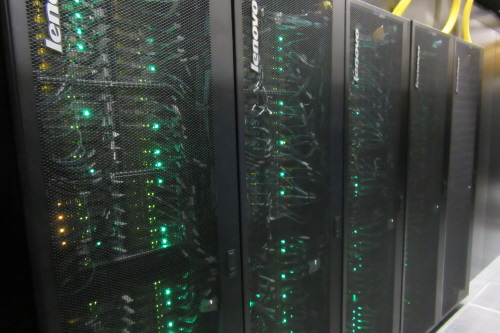Using technology to attract research and investment

It is widely recognized that supercomputers are now regarded as the 'third pillar' of modern research due to the important role they play in speeding up calculations and analysis, some of which would previously have taken many years to complete. Supercomputers are used alongside scientific theory and experimentation to complement the scientific research process.
The value and importance of High Performance Computing (HPC) at universities has grown massively over the past decade, and it’s no exception at the University of Bristol. We’ve invested more than £16 million in HPC and research data storage over the past 10 years.
In May this year we hosted a launch event for a brand new HPC, which we named 'BlueCrystal 4', or 'BC4' for short.
It’s a huge challenge for us, and universities across the UK, to continue to meet the needs of researchers and scientists and the projects they work on. BC4 is a HPC resource for the entire University, serving over 1,000 researchers, so in order for us to meet the needs of the many and cater to such a diverse range of applications and system requirements was a huge task.
For example, there have been monumental advances in genome sequencing technology. The amount of data sequencers produce is enormous and it’s only an HPC resource that’s capable of analyzing that amount of data in a timely manner.
To the uninitiated it may seem that procuring the biggest and best supercomputer is entirely altruistic -- to enable our researchers to solve some of the most difficult questions and problems that humanity faces today.
In reality though, you also need to attract highly skilled researchers to your university who can make good use of the system. Having a good-sized HPC resource attracts certain classes of researcher -- who would not be able to affectively pursue their research at universities with smaller facilities.
Thus the choice of location for research activities, groups and specialist centers is often influenced by the presence of a large and effective HPC service.
HPC is more than just a tool to enable scientific research; it’s a strategic element in attracting world-leading scientists. It attracts researchers, entire research projects and, critically, larger grants too.
Listening to researchers’ requirements
At the University, we have a rolling programme to update our HPC facilities roughly every three years. We spent a lot of time talking to researchers about their work, what they want to achieve and how supercomputing can help that.
This helps inform us about what our HPC machine should look like.
BC4 was the culmination of a lot of hard work from the team here, as well as Bristol’s integration partner, OCF, along with the technology providers DDN Storage, Lenovo, and Intel. It supports researchers from across the University.
Our new system uses Lenovo compute nodes with Intel Broadwell CPUs as well as NVIDIA GPUs. The cluster is connected to a petabyte of storage from DDN via Intel’s Omni-Path architecture and is housed off-site at VIRTUS Data Centres in Slough, due to lack of data center space on campus.
Understandably, research and teaching is already greatly benefiting from the new system, with BC4 being one of the fastest and most advanced university supercomputing facilities in the UK. It’s capable of 600 trillion calculations per second, it’s the largest UK university system by core count, which puts it at 301 on the world’s TOP500 supercomputers.
It’s all about squeezing out the very maximum performance from the hardware so, in my view, it’s vital to work with the very best technology vendors.
Where one vendor may be great at compute, another will be far better at storage. You’d be at a significant disadvantage to go with just one vendor for the whole system. This is why I think it’s important to work with a systems integrator such as OCF, which has long-standing and successful partnerships with world-leading vendors.
Not forgetting the research
It’s a long process to understand the needs of our researchers and procuring the HPC machine. It took roughly a year of hard work, but throughout that time, we never forgot why we were doing it.
Aside from attracting the very best scientists, we’re aware that BC4 had the potential to make significant contributions to science. Although only in production for just over a month it is already playing a vital role in a €1.8 million study into Ebola, looking at the speed of the virus’ evolution, and the correspondent effect on vaccines, diagnostics, and treatment.
The research, led by Dr. David Matthews, Senior Lecturer in Virology at the University, allowed the team to examine how the virus had evolved over the previous year, informing public health policy in key areas.
This is just one of many examples of how HPC at the University is contributing to significant research projects. Now in its 10th year of using HPC at Bristol, each phase from the first supercomputer through to BC4 has been bigger and better than the last and, in years to come, this trend will definitely continue.
Simon Burbidge is Director of Advanced Computing, University of Bristol.
